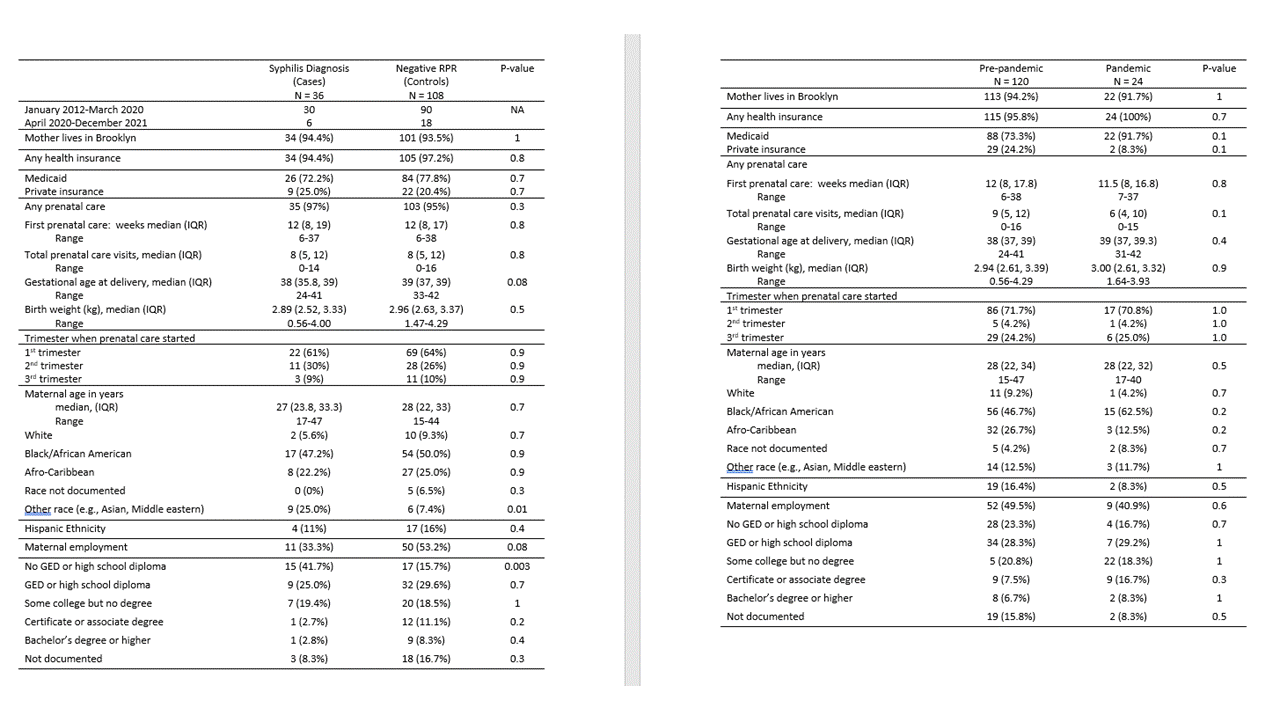Infectious Diseases
Infectious Diseases 2
638 - Maternal syphilis and congenital syphilis during COVID-19 pandemic: Case-Control Study in Brooklyn, New York 2012 – 2021
Saturday, April 29, 2023
3:30 PM - 6:00 PM ET
Poster Number: 638
Publication Number: 638.226
Publication Number: 638.226
Haram Abdelmajid, State University of New York Downstate Medical Center College of Medicine, brooklyn, NY, United States; Janet E.. Rosenbaum, SUNY Downstate Health Sciences University, Brooklyn, NY, United States; Alana Engelbrecht, State University of New York Downstate Medical Center College of Medicine, Brooklyn, NY, United States; Nicole Bogdan, Downstate, Brooklyn, NY, United States; Matthew Gesner, State University of New York Downstate Medical Center College of Medicine, Brooklyn, NY, United States; Stephan Kohlhoff, SUNY Downstate Health Sciences University, Brooklyn, NY, United States

Haram Abdelmajid, MBBS, MPH
Fellow
State University of New York Downstate Medical Center College of Medicine
brooklyn, New York, United States
Presenting Author(s)
Background: Syphilis incidence and congenital syphilis have increased dramatically in the past decade. Timely screening and treatment of syphilis during pregnancy are crucial for preventing congenital syphilis, but the COVID-19 pandemic interrupted normal prenatal care routines.
Objective: This study identified risk factors associated with maternal and congenital syphilis and whether the pandemic was associated with prenatal care disruption.
Design/Methods: We tested the hypothesis using a case-control study of pregnant patients who delivered at University Hospital of Brooklyn in years 2012 - 2021 (n = 5371). Cases had reactive Rapid Plasma Reagin antibody test (RPR) and syphilis confirmation with a treponemal antibody test (n = 36). Controls were selected 3:1 ratio from patients who gave birth in the nearest dates to the cases with non-reactive RPR during pregnancy (n = 108). This pilot study identified variables associated with maternal syphilis and with the pandemic using bivariate analysis with alpha of 0.1: Wilcoxon test for quantitative and chi-square test for categorical variables.
Results: Variables associated with syphilis case status included racial identities other than Black or White (25% of cases versus 7% of controls), lower rates of maternal employment (33% of cases versus 53% of controls), and no high school diploma or GED (42% of cases versus 16% of controls); cases delivered at earlier gestational ages (38 versus 39 weeks at median) but did not differ in the number or timing of prenatal visits. Among infants born to mothers who had syphilis during pregnancy, 27 (75%) infants required treatment due to inadequate maternal treatment: 33% with single dose of penicillin and 67% for 10 days for probable congenital syphilis. During the pandemic, all births were covered by insurance and both cases and controls had fewer prenatal visits (median 6 visits (IQR 4-10) during the pandemic versus 9 (IQR 5-12) before the pandemic), but more births were covered by Medicaid (92% of pandemic births vs. 73% of pre-pandemic births).
Conclusion(s): In our hospital population, syphilis was associated with low socioeconomic status and non-Black/non-White racial identities. The pandemic was associated with fewer prenatal visits among both cases and controls. The pandemic public health emergency facilitated Medicaid continuity, which benefitted the low-SES enrollees at greatest risk of both maternal syphilis and Medicaid disenrollment. The maternal syphilis burden may have been greater without this Medicaid continuity, and this population will be at greater risk when the public health emergency ends as early as March 2023.

